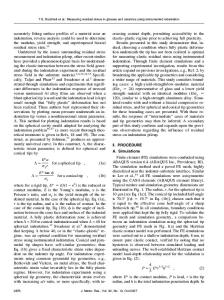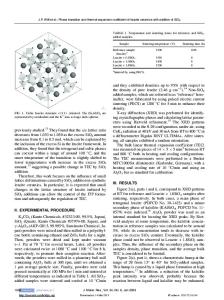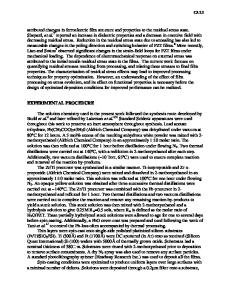Residual stress in ceramics with large thermal expansion anisotropy
- PDF / 278,286 Bytes
- 9 Pages / 612 x 792 pts (letter) Page_size
- 12 Downloads / 472 Views
Welcome
MATERIALS RESEARCH
Comments
Help
Residual stress in ceramics with large thermal expansion anisotropy S. W. Paulik, M. H. Zimmerman, and K. T. Faber Department of Materials Science and Engineering, Robert R. McCormick School of Engineering and Applied Science, Northwestern University, Evanston, Illinois 60208-3108
E. R. Fuller, Jr. National Institute of Standards and Technology, Gaithersburg, Maryland 20899 (Received 10 March 1995; accepted 27 June 1996)
Residual stress was measured in sintered and heat-treated Fe2 TiO5 samples with various grain sizes. The influence of texturing was assessed by comparing the residual stress states of samples having randomly oriented grains and highly oriented grains produced through magnetically assisted processing. The residual stress was measured with x-ray diffraction using Cr Ka radiation. Due to the significant texture and the consequential oscillations in the dfc vs sin2 c data, the residual stress was calculated using the Marion –Cohen method. Textured samples showed significantly lower residual stresses except when spontaneous microcracking accompanied grain growth in the randomly oriented systems. Elastic modulus measurements showed a direct correlation between the decrease in residual stress and the microcrack density.
I. INTRODUCTION
Much interest has been focused on the mechanical behavior of single-phase polycrystalline ceramics with large thermal expansion anisotropy.1–22 Several theories2–12,22 have been developed to predict the dependence of these properties on grain size. In particular, conditions whereby spontaneous cracking occurs have been defined. Several equations have been derived2–11,22 describing the critical grain size for spontaneous microcracking in terms of material parameters, having the following general form: lcs
kggb EsDamaxDTd2
,
(1)
where lcs is the grain facet length at the onset of spontaneous microcracking, k is a model dependent constant, ggb is an isotropic grain boundary surface energy, E is Young’s modulus, Damax is the difference between maximum and average thermal expansion coefficients (amax 2 a), and DT is the difference between the strainfree temperature and the temperature of interest. A common element in these studies is the use of a uniform distribution of grain orientations to simulate the thermal expansion mismatch strains inherent in these systems. The critical grain size for spontaneous microcracking can be calculated using Eq. (1); this value, however, applies only to a polycrystalline material with a random distribution of grains. The residual stress generated during cooling has been estimated by considering two grains with a common boundary in an isotropic matrix. Maximum thermal J. Mater. Res., Vol. 11, No. 11, Nov 1996
http://journals.cambridge.org
Downloaded: 26 Mar 2015
strain is created when the average coefficient of thermal ' expansion normal to the shared boundary, a ' 12 sa1 1 ' ' a2 dy2, is most different from the bulk; i.e., a 12 amax . The resulting stress in this grain pair is related
Data Loading...











